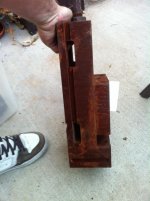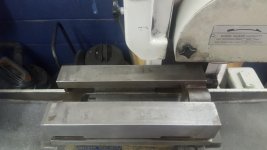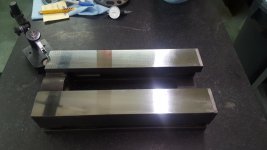KC130Loadie
Aluminum
- Joined
- Oct 24, 2014
- Location
- San Diego, Bay Park
I'd thought I'd share an in progress vise rehab. Picked up this baby on the cheap. A Kurt II PT600. All rusted up and stuck together bigtime. Busted out the car battery charger and some baking soda and 1 week later these are the results. It probably took about an hour of light scrubbing with oil and a soft scotch brite pad to remove the converted rust. There are some tooling marks on the movable jaw; looks like a 3 fluted facemill was crashed into it, and there is about a .100-.150 cut in the top of the fixed jaw, but the rest looks good. Not any pitting that would impede function by any means. Most likely will stone the "ways" for any possible high spots.
The screw and bearings all look brand new, but the bearing retainer? had evidence of chips galling up between it and the casting. Might bore it a touch to clean out the marks...or not.





http://i1290.photobucket.com/albums/b526/KC130Loadie/IMG_1545_zpscsj8uhft.jpg
http://i1290.photobucket.com/albums/b526/KC130Loadie/IMG_1543_zpsfcshv1lp.jpg
http://i1290.photobucket.com/albums/b526/KC130Loadie/IMG_1546_zpseolhtvlk.jpg
http://i1290.photobucket.com/albums/b526/KC130Loadie/IMG_1550_zpszpfbj2ds.jpg
http://i1290.photobucket.com/albums/b526/KC130Loadie/IMG_1551_zpslkgjnwcz.jpg
http://i1290.photobucket.com/albums/b526/KC130Loadie/IMG_1564_zpswfr8tjgw.jpg
http://i1290.photobucket.com/albums/b526/KC130Loadie/IMG_1566_zps4ddnwnfl.jpg
http://i1290.photobucket.com/albums/b526/KC130Loadie/IMG_1570_zpsawmjunqg.jpg
http://i1290.photobucket.com/albums/b526/KC130Loadie/IMG_1157%201_zpssqdk4buf.jpg
http://i1290.photobucket.com/albums/b526/KC130Loadie/IMG_1161_zps2zapexom.jpg
http://i1290.photobucket.com/albums/b526/KC130Loadie/IMG_1160_zpsuahycrao.jpg
The screw and bearings all look brand new, but the bearing retainer? had evidence of chips galling up between it and the casting. Might bore it a touch to clean out the marks...or not.





http://i1290.photobucket.com/albums/b526/KC130Loadie/IMG_1545_zpscsj8uhft.jpg
http://i1290.photobucket.com/albums/b526/KC130Loadie/IMG_1543_zpsfcshv1lp.jpg
http://i1290.photobucket.com/albums/b526/KC130Loadie/IMG_1546_zpseolhtvlk.jpg
http://i1290.photobucket.com/albums/b526/KC130Loadie/IMG_1550_zpszpfbj2ds.jpg
http://i1290.photobucket.com/albums/b526/KC130Loadie/IMG_1551_zpslkgjnwcz.jpg
http://i1290.photobucket.com/albums/b526/KC130Loadie/IMG_1564_zpswfr8tjgw.jpg
http://i1290.photobucket.com/albums/b526/KC130Loadie/IMG_1566_zps4ddnwnfl.jpg
http://i1290.photobucket.com/albums/b526/KC130Loadie/IMG_1570_zpsawmjunqg.jpg
http://i1290.photobucket.com/albums/b526/KC130Loadie/IMG_1157%201_zpssqdk4buf.jpg
http://i1290.photobucket.com/albums/b526/KC130Loadie/IMG_1161_zps2zapexom.jpg
http://i1290.photobucket.com/albums/b526/KC130Loadie/IMG_1160_zpsuahycrao.jpg


 Especially for removing the black coating at the end....
Especially for removing the black coating at the end....




 )
)
